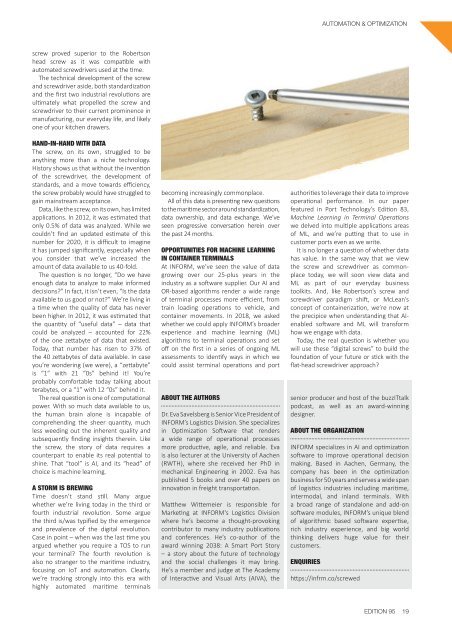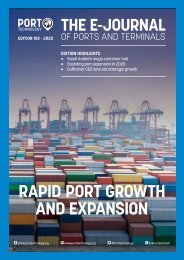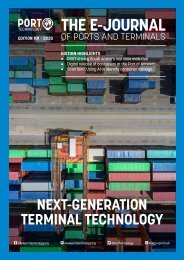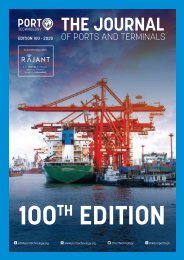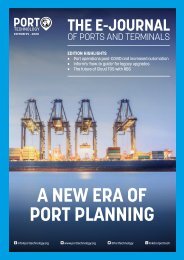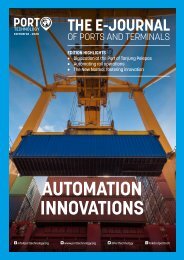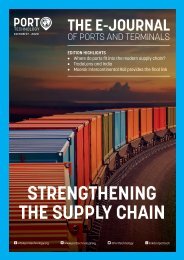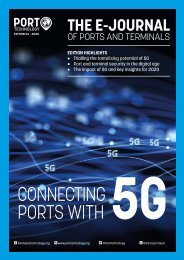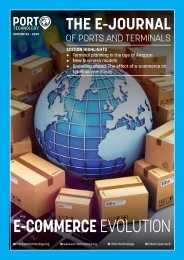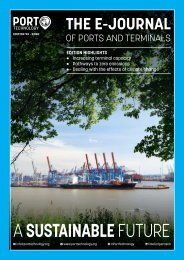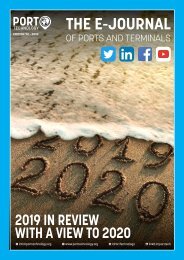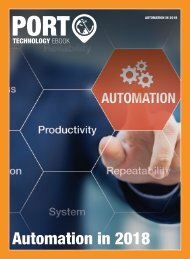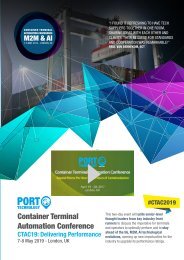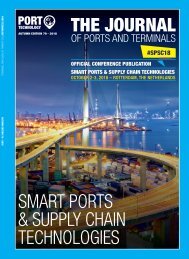Automation's Next Step
This edition of The Journal considers automation of container terminals and how the industry is delivering the next steps towards full and semi-automation. With the inclusion of over 30 technical papers The Journal also explores terminal planning in the age of automation, environmental sustainability for ports, the impact of mega ships and other topics. Automation continues to drive innovation across several industries, and there is no greater example of this than maritime. However, implementation, technology and best practices continue to be a constant source of debate and analysis across the sector, as is shown in this edition of the PTI Journal. The automation debate is not new, but it remains a booming market and a source of growth for the wider container terminal industry. One thing is for certain, automation is here to stay.
This edition of The Journal considers automation of container terminals and how the industry is delivering the next steps towards full and semi-automation.
With the inclusion of over 30 technical papers The Journal also explores terminal planning in the age of automation, environmental sustainability for ports, the impact of mega ships and other topics.
Automation continues to drive innovation across several industries, and there is no greater example of this than maritime.
However, implementation, technology and best practices continue to be a constant source of debate and analysis across the sector, as is shown in this edition of the PTI Journal.
The automation debate is not new, but it remains a booming market and a source of growth for the wider container terminal industry.
One thing is for certain, automation is here to stay.
You also want an ePaper? Increase the reach of your titles
YUMPU automatically turns print PDFs into web optimized ePapers that Google loves.
AUTOMATION & OPTIMIZATION<br />
screw proved superior to the Robertson<br />
head screw as it was compatible with<br />
automated screwdrivers used at the time.<br />
The technical development of the screw<br />
and screwdriver aside, both standardization<br />
and the first two industrial revolutions are<br />
ultimately what propelled the screw and<br />
screwdriver to their current prominence in<br />
manufacturing, our everyday life, and likely<br />
one of your kitchen drawers.<br />
HAND-IN-HAND WITH DATA<br />
The screw, on its own, struggled to be<br />
anything more than a niche technology.<br />
History shows us that without the invention<br />
of the screwdriver, the development of<br />
standards, and a move towards efficiency,<br />
the screw probably would have struggled to<br />
gain mainstream acceptance.<br />
Data, like the screw, on its own, has limited<br />
applications. In 2012, it was estimated that<br />
only 0.5% of data was analyzed. While we<br />
couldn’t find an updated estimate of this<br />
number for 2020, it is difficult to imagine<br />
it has jumped significantly, especially when<br />
you consider that we’ve increased the<br />
amount of data available to us 40-fold.<br />
The question is no longer, “Do we have<br />
enough data to analyze to make informed<br />
decisions?” In fact, it isn’t even, “Is the data<br />
available to us good or not?” We’re living in<br />
a time when the quality of data has never<br />
been higher. In 2012, it was estimated that<br />
the quantity of “useful data” – data that<br />
could be analyzed – accounted for 22%<br />
of the one zettabyte of data that existed.<br />
Today, that number has risen to 37% of<br />
the 40 zettabytes of data available. In case<br />
you’re wondering (we were), a “zettabyte”<br />
is “1” with 21 “0s” behind it! You’re<br />
probably comfortable today talking about<br />
terabytes, or a “1” with 12 “0s” behind it.<br />
The real question is one of computational<br />
power. With so much data available to us,<br />
the human brain alone is incapable of<br />
comprehending the sheer quantity, much<br />
less weeding out the inherent quality and<br />
subsequently finding insights therein. Like<br />
the screw, the story of data requires a<br />
counterpart to enable its real potential to<br />
shine. That “tool” is AI, and its “head” of<br />
choice is machine learning.<br />
A STORM IS BREWING<br />
Time doesn’t stand still. Many argue<br />
whether we’re living today in the third or<br />
fourth industrial revolution. Some argue<br />
the third is/was typified by the emergence<br />
and prevalence of the digital revolution.<br />
Case in point – when was the last time you<br />
argued whether you require a TOS to run<br />
your terminal? The fourth revolution is<br />
also no stranger to the maritime industry,<br />
focusing on IoT and automation. Clearly,<br />
we’re tracking strongly into this era with<br />
highly automated maritime terminals<br />
becoming increasingly commonplace.<br />
All of this data is presenting new questions<br />
to the maritime sector around standardization,<br />
data ownership, and data exchange. We’ve<br />
seen progressive conversation herein over<br />
the past 24 months.<br />
OPPORTUNITIES FOR MACHINE LEARNING<br />
IN CONTAINER TERMINALS<br />
At INFORM, we’ve seen the value of data<br />
growing over our 25-plus years in the<br />
industry as a software supplier. Our AI and<br />
OR-based algorithms render a wide range<br />
of terminal processes more efficient, from<br />
train loading operations to vehicle, and<br />
container movements. In 2018, we asked<br />
whether we could apply INFORM’s broader<br />
experience and machine learning (ML)<br />
algorithms to terminal operations and set<br />
off on the first in a series of ongoing ML<br />
assessments to identify ways in which we<br />
could assist terminal operations and port<br />
ABOUT THE AUTHORS<br />
Dr. Eva Savelsberg is Senior Vice President of<br />
INFORM’s Logistics Division. She specializes<br />
in Optimization Software that renders<br />
a wide range of operational processes<br />
more productive, agile, and reliable. Eva<br />
is also lecturer at the University of Aachen<br />
(RWTH), where she received her PhD in<br />
mechanical Engineering in 2002. Eva has<br />
published 5 books and over 40 papers on<br />
innovation in freight transportation.<br />
Matthew Wittemeier is responsible for<br />
Marketing at INFORM's Logistics Division<br />
where he’s become a thought-provoking<br />
contributor to many industry publications<br />
and conferences. He’s co-author of the<br />
award winning 2038: A Smart Port Story<br />
– a story about the future of technology<br />
and the social challenges it may bring.<br />
He’s a member and judge at The Academy<br />
of Interactive and Visual Arts (AIVA), the<br />
authorities to leverage their data to improve<br />
operational performance. In our paper<br />
featured in Port Technology’s Edition 83,<br />
Machine Learning in Terminal Operations<br />
we delved into multiple applications areas<br />
of ML, and we’re putting that to use in<br />
customer ports even as we write.<br />
It is no longer a question of whether data<br />
has value. In the same way that we view<br />
the screw and screwdriver as commonplace<br />
today, we will soon view data and<br />
ML as part of our everyday business<br />
toolkits. And, like Robertson’s screw and<br />
screwdriver paradigm shift, or McLean’s<br />
concept of containerization, we’re now at<br />
the precipice when understanding that AIenabled<br />
software and ML will transform<br />
how we engage with data.<br />
Today, the real question is whether you<br />
will use these “digital screws” to build the<br />
foundation of your future or stick with the<br />
flat-head screwdriver approach?<br />
senior producer and host of the buzzITtalk<br />
podcast, as well as an award-winning<br />
designer.<br />
ABOUT THE ORGANIZATION<br />
INFORM specializes in AI and optimization<br />
software to improve operational decision<br />
making. Based in Aachen, Germany, the<br />
company has been in the optimization<br />
business for 50 years and serves a wide span<br />
of logistics industries including maritime,<br />
intermodal, and inland terminals. With<br />
a broad range of standalone and add-on<br />
software modules, INFORM’s unique blend<br />
of algorithmic based software expertise,<br />
rich industry experience, and big world<br />
thinking delivers huge value for their<br />
customers.<br />
ENQUIRIES<br />
https://infrm.co/screwed<br />
EDITION 95 19


